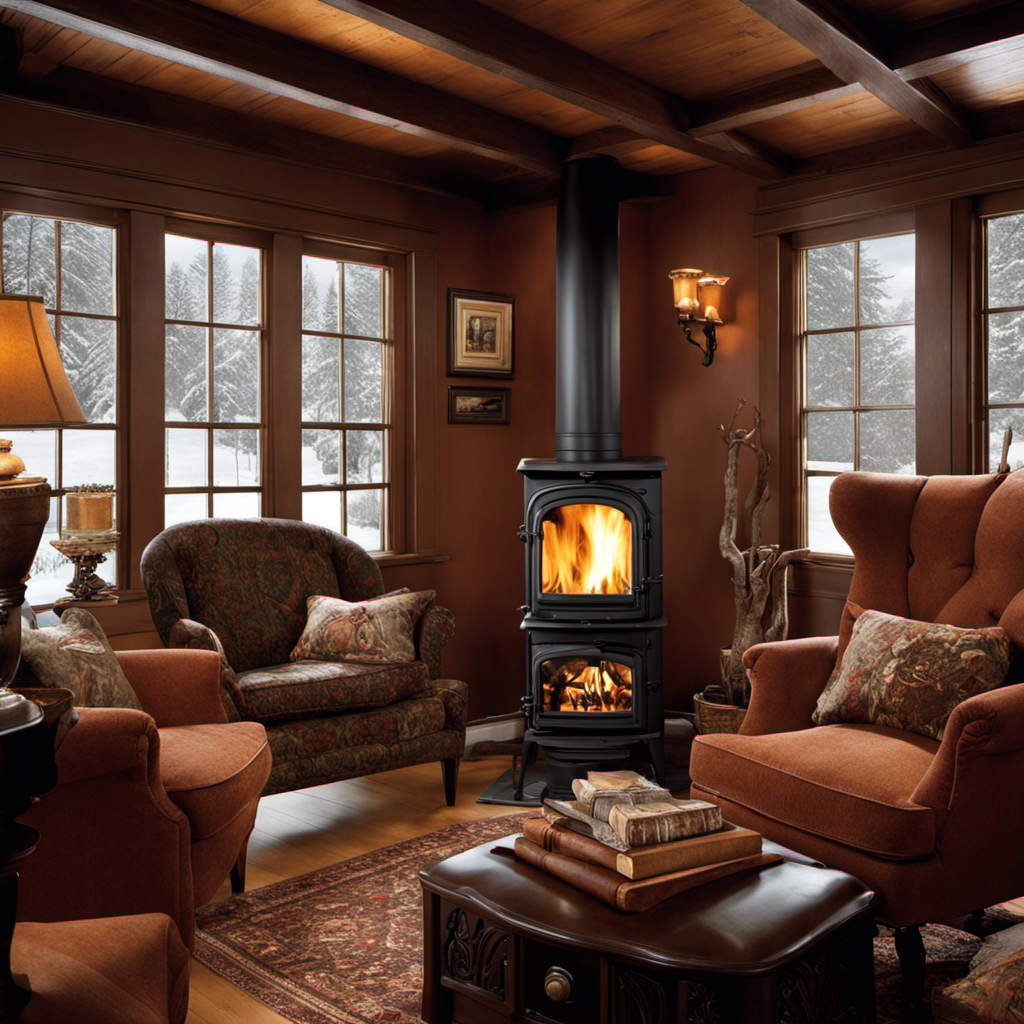Standing in front of the towering smokestack, serving as a solemn reminder of the past heat emanating from it, I realized it was time to start the cleaning journey.
With my trusty tools in hand, I delved into the depths of the wood stove chimney, determined to remove every speck of soot and debris.
In this guide, I will share my step-by-step process for cleaning a wood stove chimney from the bottom up, ensuring its efficiency and safety for years to come.
Key Takeaways
- Regular chimney cleaning is essential for the safety and efficiency of a wood stove.
- A dirty chimney can increase the risk of chimney fires and carbon monoxide poisoning.
- Proper ventilation, use of dry and seasoned wood, and following manufacturer’s instructions are important for minimizing smoke and creosote buildup.
- Regular inspections and prompt addressing of any issues or damage are crucial for maintaining the safety of the chimney.
Importance of Regular Chimney Cleaning
Regular chimney cleaning is crucial to ensure the safety and efficiency of my wood stove. As a homeowner, I understand the importance of professional cleaning to maintain the optimal functioning of my chimney. A dirty chimney can pose several risks, including increased chances of chimney fires and carbon monoxide poisoning.
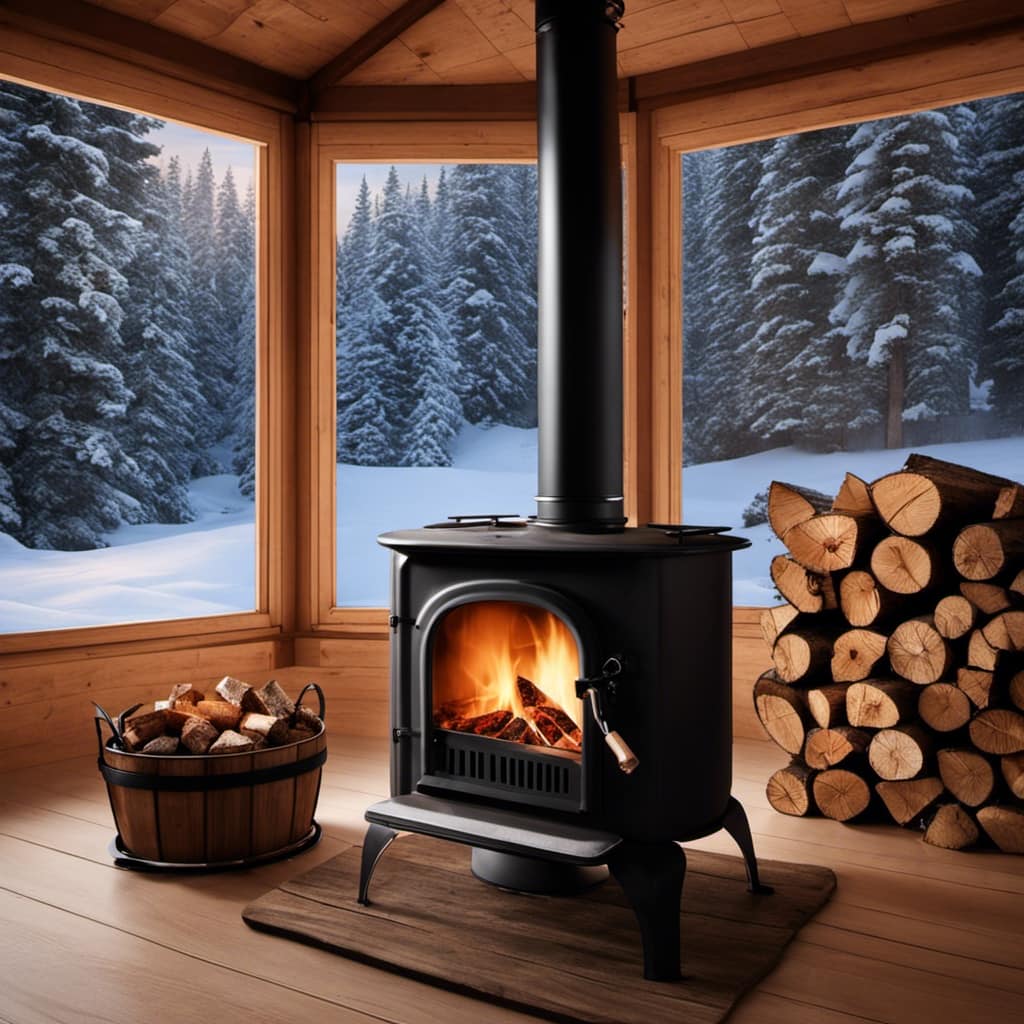
One of the signs that indicate a dirty chimney is a buildup of soot or creosote. Soot is a black, powdery substance that forms when wood is burned, while creosote is a sticky, tar-like substance that accumulates in the chimney. These substances can obstruct the airflow and cause the smoke to back up into the house. Additionally, a dirty chimney may emit a strong, unpleasant odor due to the accumulation of debris and animal droppings.
Regular chimney cleaning by a professional ensures that these hazards are mitigated. A professional chimney sweep has the expertise and specialized equipment to thoroughly clean the chimney, removing any soot, creosote, or debris. They can also identify any potential issues, such as damaged chimney liners or obstructions, and address them promptly.
In conclusion, regular chimney cleaning is essential for the safety and efficiency of my wood stove. By hiring a professional to clean my chimney, I can prevent chimney fires, reduce the risk of carbon monoxide poisoning, and ensure that my wood stove operates at its best.
Don’t overlook the importance of professional chimney cleaning to maintain the integrity of your home and keep your family safe.
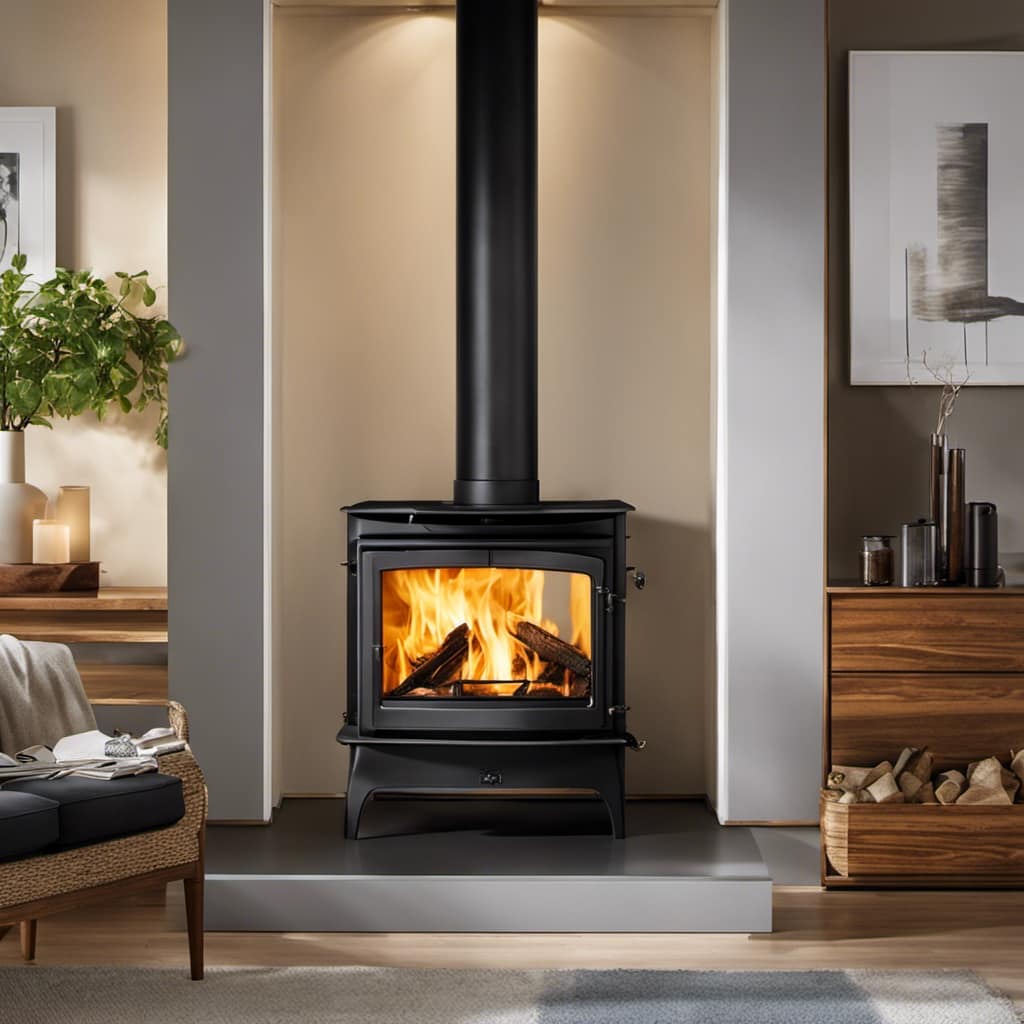
Tools and Materials Needed for Cleaning
I’ll need a wire brush, a chimney brush, a ladder, gloves, and safety goggles for the cleaning process. These are the necessary equipment needed to effectively clean a wood stove chimney from the bottom up.
The wire brush is essential for removing any debris or creosote buildup that may have accumulated in the chimney. It’s important to use a chimney brush specifically designed for the type and size of your chimney. This will ensure that you’re able to reach all areas of the chimney and thoroughly clean it.
A ladder is necessary to access the chimney from the bottom, allowing you to properly reach and clean the entire length. Safety goggles and gloves are also vital to protect yourself from any debris or harmful chemicals that may be present during the cleaning process.
In addition to the necessary equipment, it’s important to have the right cleaning solutions. These solutions are designed to effectively break down and remove any creosote or soot buildup in the chimney. Using the proper cleaning solutions will ensure that your chimney is thoroughly cleaned and safe to use.

Preparing the Wood Stove for Cleaning
To get started, I need to gather all the necessary tools and materials for preparing the wood stove. Before I begin cleaning, I always conduct a pre-cleaning inspection to ensure everything is in good condition.
First, I make sure I’ve a flashlight handy to inspect the inside of the stove. Then, I carefully examine the stove’s components, checking for any signs of damage or wear.
Next, I remove any ashes that may be present in the stove. This is an important step as it allows for better access to the chimney during the cleaning process. To remove the ashes, I use a metal ash shovel and a metal bucket to safely collect and dispose of them. It’s crucial to wait until the ashes have completely cooled before handling them.
Once the ashes are removed, I’m ready to move on to the next step of cleaning the wood stove chimney from the bottom up.

Step-by-Step Guide to Cleaning the Chimney
Inspecting the chimney from top to bottom is an important step in ensuring its cleanliness and functionality. A thorough chimney inspection involves checking for any signs of damage or blockage that may affect the proper operation of the chimney. One common technique used during a chimney inspection is a visual inspection using a flashlight and mirror. This allows me to examine the interior of the chimney for any cracks, creosote buildup, or obstructions. I also check the chimney cap and flue to ensure they’re in good condition and functioning properly.
Another important aspect of chimney inspection is checking the chimney liner. A damaged or deteriorated liner can pose serious safety risks and should be repaired or replaced immediately. I carefully examine the liner for any signs of corrosion, cracks, or deterioration. It’s also crucial to inspect the chimney exterior for any signs of damage, such as loose bricks or mortar, which can lead to structural issues.
In addition to the visual inspection, chimney sweeping techniques are employed to remove any creosote buildup or debris. This can be done using specialized chimney brushes and rods. The brushes are attached to the rods and inserted into the chimney, allowing me to scrub away the creosote and soot. It’s important to use the right size brush to ensure effective cleaning.
Tips for Maintaining a Clean Chimney
Maintaining a clean chimney requires regular maintenance and proper use of fireplace accessories. To keep your chimney in top condition and prevent chimney fires, follow these tips:

-
Schedule regular chimney inspections: Have a professional inspect your chimney at least once a year to identify any potential issues or buildup that could lead to a fire. They’ll also check for any damage or cracks in the chimney structure that need repair.
-
Clean your chimney regularly: Regular chimney cleaning is essential to remove creosote buildup, which is highly flammable. Hire a professional chimney sweep or use a chimney brush and rods to clean it yourself. Make sure to wear protective gear and cover the fireplace opening to prevent soot from spreading into your home.
-
Use proper fireplace accessories: Using the right accessories can help prevent chimney fires. Install a chimney cap to keep debris, animals, and birds out of your chimney. Use a spark arrestor to prevent sparks from flying out and potentially igniting nearby flammable materials.
Ensuring Safety and Proper Ventilation
To ensure safety and proper ventilation, I always prioritize two key factors: managing carbon monoxide risks and clearing any airway obstructions.

Carbon monoxide, a colorless and odorless gas, can be lethal if not properly managed. Therefore, it’s crucial to have carbon monoxide detectors installed near the wood stove and regularly check their functionality.
Additionally, I make sure to keep the area around the stove clear of any obstructions to guarantee proper airflow and prevent potential fire hazards.
Carbon Monoxide Risks
I’ve heard that carbon monoxide can be a serious risk when it comes to wood stove chimneys. This colorless, odorless gas is produced when wood doesn’t burn completely. It can seep into your home through cracks or leaks in the chimney, leading to carbon monoxide poisoning.
The symptoms of carbon monoxide poisoning include headache, dizziness, nausea, confusion, and even death. To prevent this, it’s important to take necessary precautions. Here are some key measures to keep in mind:
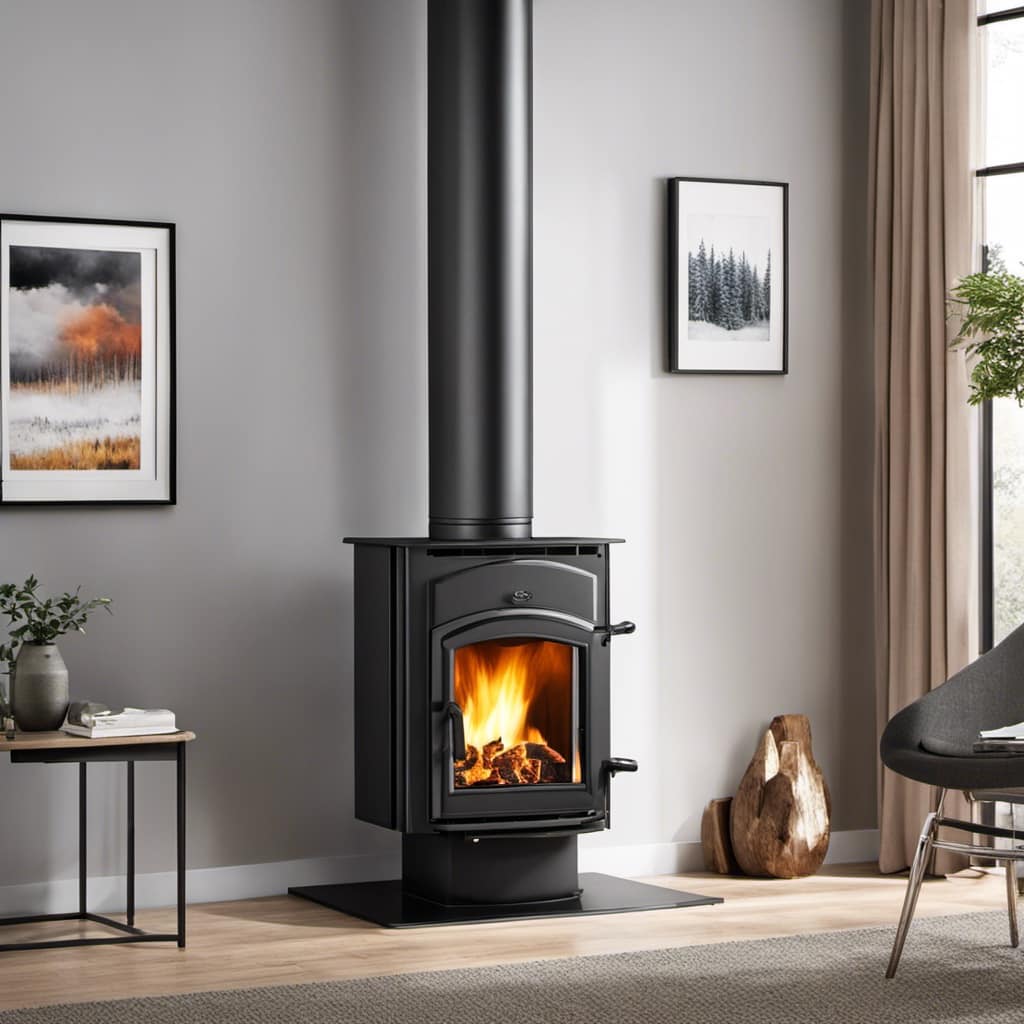
- Install carbon monoxide detectors in your home.
- Regularly inspect and clean your wood stove chimney to ensure proper ventilation.
- Have a professional chimney sweep perform an annual inspection and cleaning to remove any build-up or blockages.
Clearing Airway Obstructions
When it comes to preventing airway obstructions, it’s important to be aware of potential hazards and take necessary precautions. Clearing debris from your wood stove chimney is crucial to ensure proper airflow and prevent dangerous blockages.
One effective technique is using a chimney brush to remove built-up soot, creosote, and other debris. Start by attaching the brush to a flexible rod and inserting it into the chimney from the bottom. Move the brush up and down, using a twisting motion to dislodge any obstructions.
As you brush, make sure to wear protective gloves and a dust mask to avoid inhaling harmful particles. After clearing the debris, it’s important to inspect the chimney for any signs of damage or deterioration.
Regular maintenance and cleaning will help keep your wood stove chimney clear and safe.
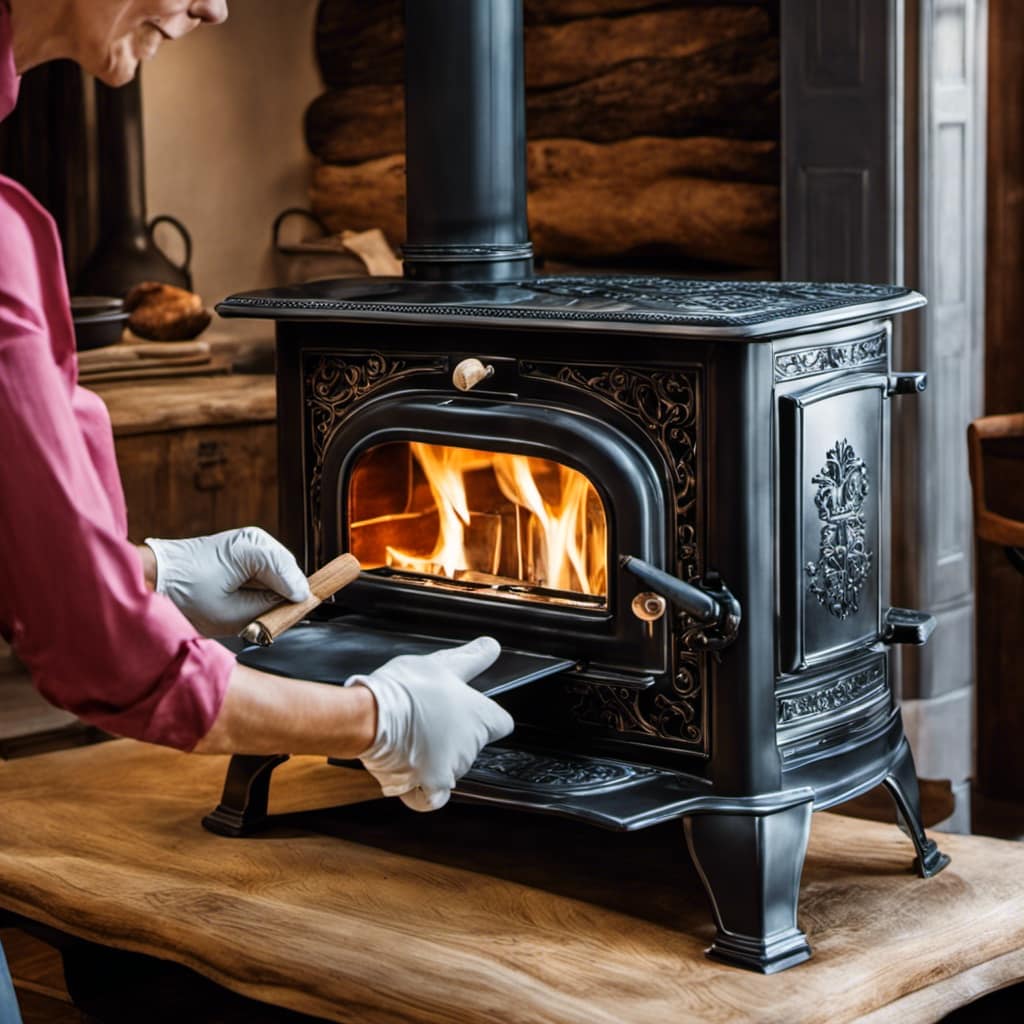
Frequently Asked Questions
How Often Should I Clean My Wood Stove Chimney?
I schedule professional chimney cleaning for my wood stove regularly to ensure optimal performance and safety. Neglecting to clean the chimney can lead to potential risks such as chimney fires, carbon monoxide buildup, and reduced efficiency.
It’s recommended to have a professional chimney cleaning at least once a year, or more frequently if you use your wood stove frequently or burn wet or unseasoned wood.
Regular cleaning will help maintain the longevity and functionality of your wood stove.
Can I Use Regular Household Cleaning Products to Clean My Chimney?
I wouldn’t recommend using regular household cleaning products to clean a chimney.
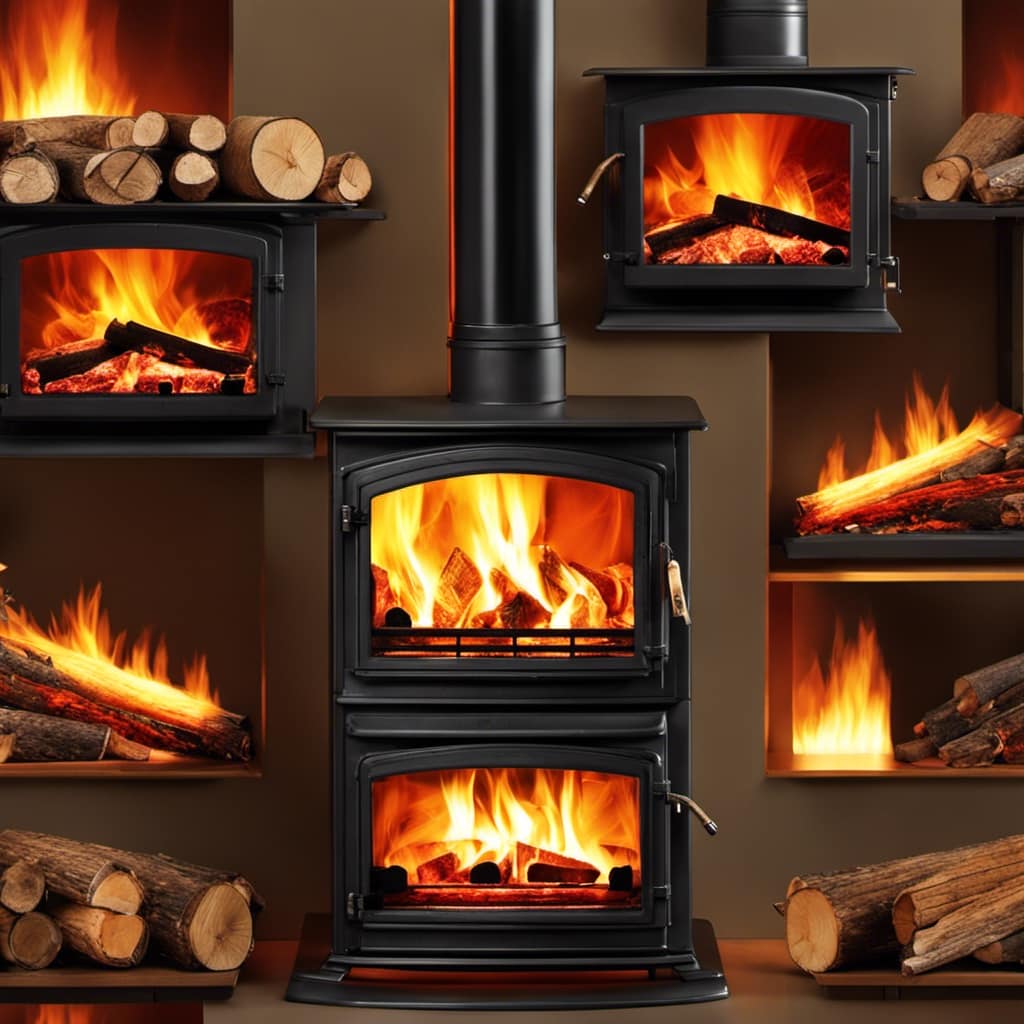
Chimneys require specialized cleaning products that can effectively remove creosote buildup and other debris.
Regular household cleaning products may not be strong enough to properly clean the chimney and could potentially cause damage.
It’s best to use products specifically designed for chimney cleaning or consult a professional chimney sweep for alternative methods.
Is It Necessary to Hire a Professional for Chimney Cleaning or Can I Do It Myself?
Personally, I’ve considered whether to hire a professional or tackle DIY chimney cleaning. While the allure of saving money is tempting, it’s crucial to weigh the pros and cons.
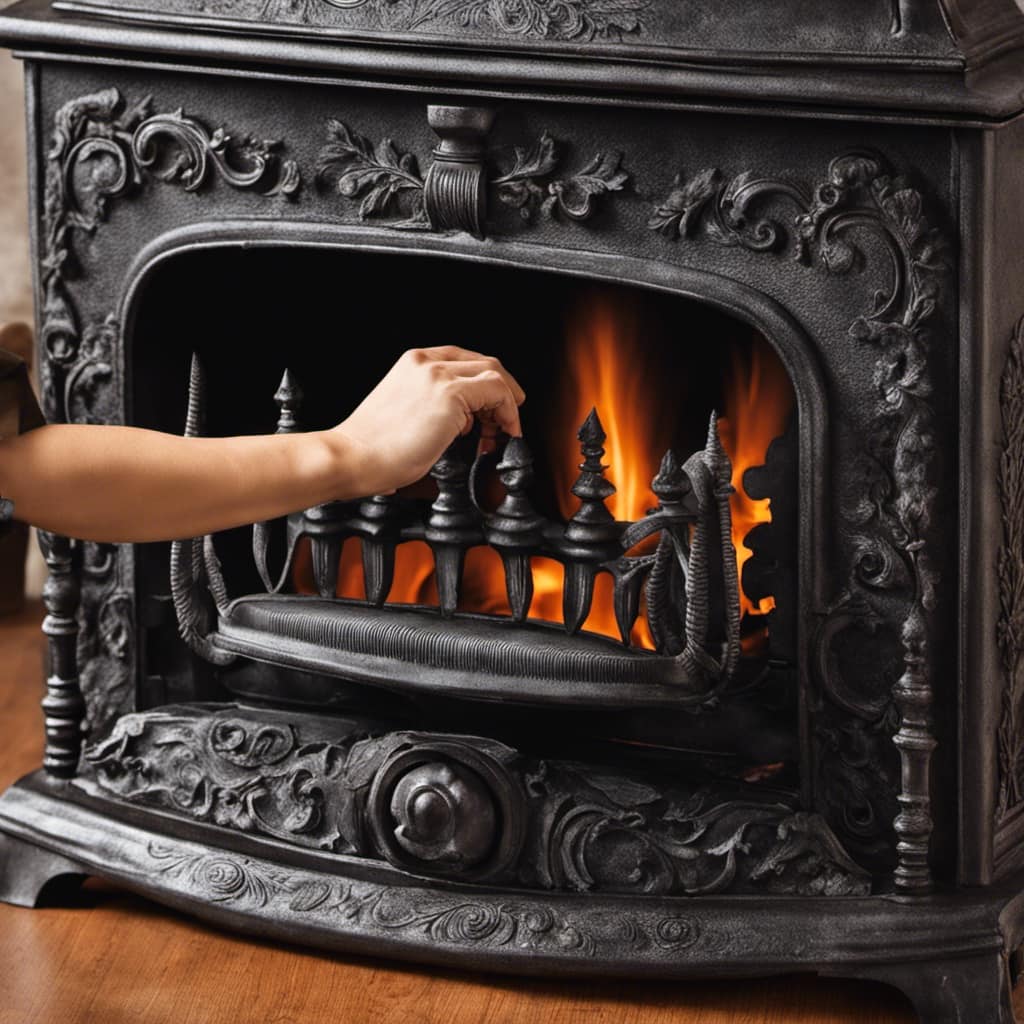
DIY chimney cleaning offers a sense of accomplishment and cost savings, but it requires proper knowledge, tools, and safety precautions. On the other hand, professionals bring expertise, specialized equipment, and ensure a thorough cleaning.
Ultimately, the choice depends on your comfort level, time, and commitment to safety.
What Are the Signs of a Dirty or Clogged Chimney?
When it comes to the signs of a dirty or clogged chimney, there are a few key things to look out for. One of the most common signs is a buildup of soot or creosote, which can lead to poor airflow and increased risk of chimney fires.
Other signs include a strong, smoky smell in your home, excessive amounts of smoke coming from the chimney, and difficulty starting or maintaining a fire.
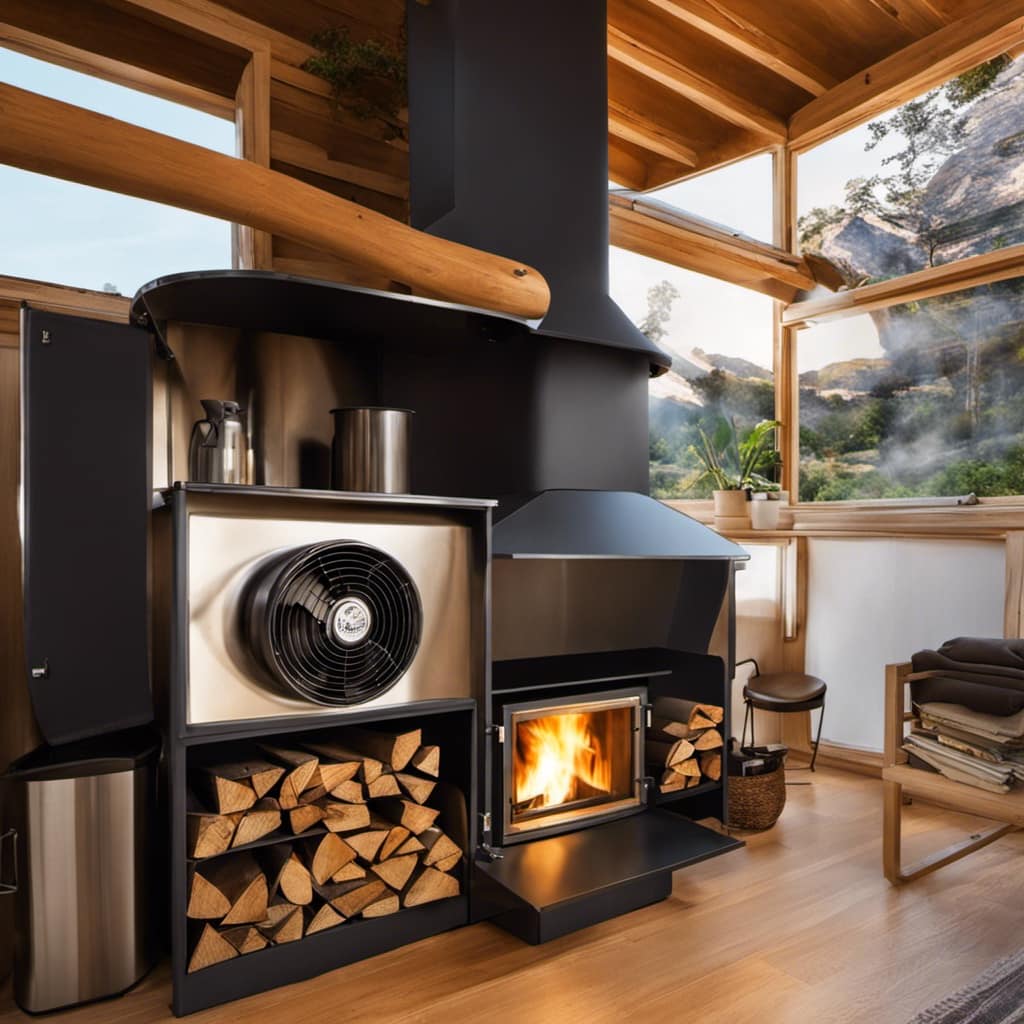
Regular chimney cleaning is important to prevent these issues and ensure the safe and efficient operation of your wood stove.
How Long Does It Typically Take to Clean a Wood Stove Chimney From the Bottom Up?
On average, it takes about 1-2 hours to clean a wood stove chimney from the bottom up. However, the time can vary depending on the size and condition of the chimney.
It’s important to note that rushing through the cleaning process can lead to common mistakes, such as incomplete removal of creosote or missing damaged components.
Therefore, it’s crucial to take your time and follow proper cleaning procedures for a safe and effective chimney cleaning.
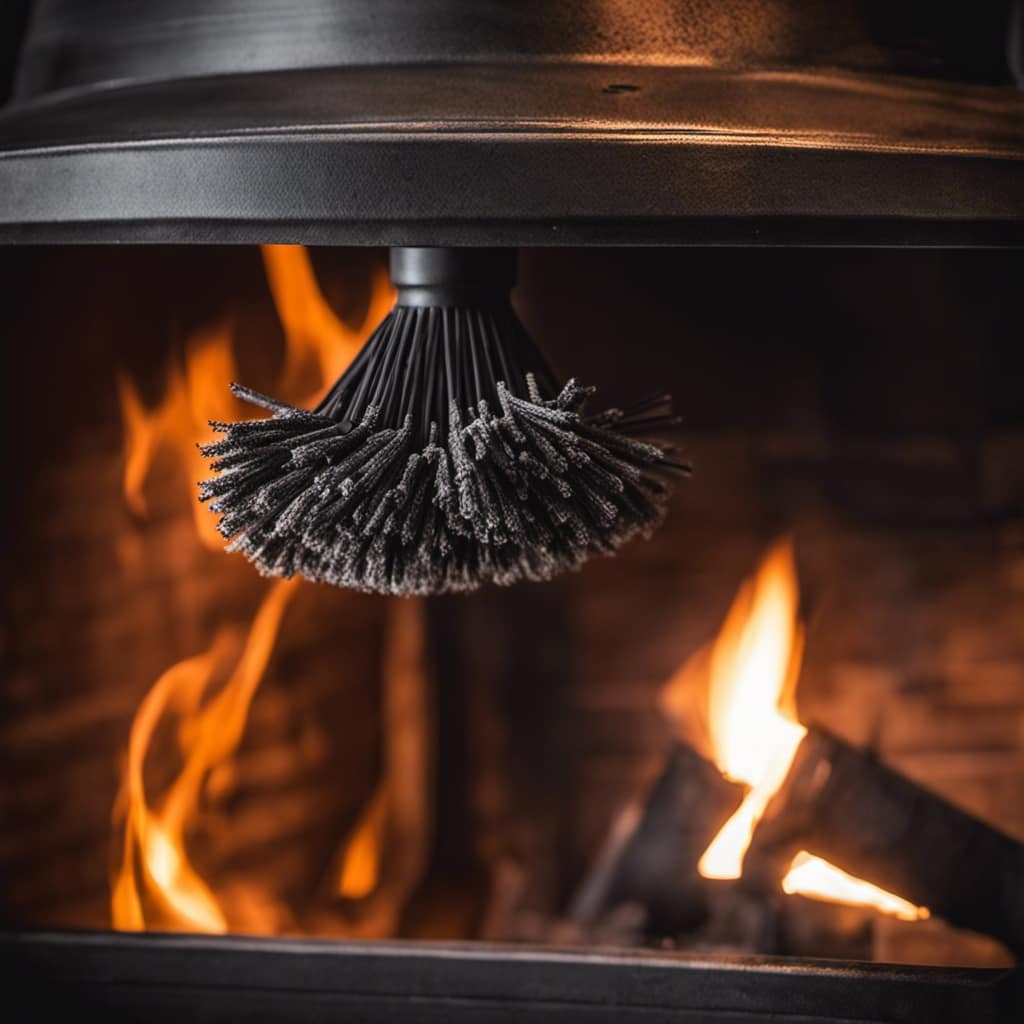
Conclusion
Regularly cleaning your wood stove chimney is of utmost importance to ensure safety and proper ventilation.
By following the step-by-step guide and using the necessary tools and materials, you can easily clean your chimney from the bottom up.
Remember to maintain a clean chimney to prevent potential hazards and ensure efficient heating.
Take charge of your chimney’s cleanliness and enjoy a cozy and safe wood stove experience.

Growing up surrounded by the vast beauty of nature, Sierra was always drawn to the call of the wild. While others sought the comfort of the familiar, she ventured out, embracing the unpredictable and finding stories in the heartbeat of nature.
At the epicenter of every remarkable venture lies a dynamic team—a fusion of diverse talents, visions, and passions. The essence of Best Small Wood Stoves is crafted and refined by such a trio: Sierra, Logan, and Terra. Their collective expertise has transformed the platform into a leading authority on small wood stoves, radiating warmth and knowledge in equal measure.






